鲁迅翻译理论的发展及评价
- 格式:pdf
- 大小:170.55 KB
- 文档页数:4
![[鲁迅翻译思想的文化解读] 鲁迅作品主题思想](https://uimg.taocdn.com/790da1c7fc4ffe473268ab3b.webp)
《[鲁迅翻译思想的文化解读] 鲁迅作品主题思想》摘要:超越语言表层,探究鲁迅“直译”和“复译”的深层含义,可以发现鲁迅提出“直译”和“复译”旨在改造中国语言文化、与“受侮辱、受压迫的弱小国家”构建平等的民族关系,基于以上考虑,笔者通过深入挖掘鲁迅作品中的“译者记”、“小引”、书信、序、跋以及数量不少的翻译专论,从文化层面解读鲁迅翻译思想的两个方面:直译,硬译、重译,复译,晚清民初时期,“直译”不仅在翻译实践中极少使用,而且这种方法往往跟“率尔操觚”、“佶屈聱牙”、“味同嚼蜡”、“无从索解”和“释家经咒”联系在一起关键词:硬译复译文化解读摘要:鲁迅的翻译思想并不局限于语言表层,而是一种改造中国语言文化、构建平等的民族关系的文化策略。
超越语言表层,探究鲁迅“直译”和“复译”的深层含义,可以发现鲁迅提出“直译”和“复译”旨在改造中国语言文化、与“受侮辱、受压迫的弱小国家”构建平等的民族关系。
在鲁迅一生的笔墨生涯中,翻译占据了重要地位。
他从事翻译的时间前后长达33年之久,共译介了14个国家近100位作家,200多种作品,共计300多万字,占据鲁迅笔墨的半壁江山。
鲁迅本人也非常重视翻译,把翻译与创作同等看待,他痛恨轻视翻译,将翻译看作是“媒婆”的言论和行为。
在纪念鲁迅逝世70周年时,北京鲁迅博物馆馆长、鲁迅研究专家孙郁说:“鲁迅首先是翻译家,其次才是作家,他把大量的精力用在翻译,而且他瞧不起自己的创作。
”翻译研究在鲁迅研究中的重要性可见一斑。
然而,译家鲁迅的研究长期受到了冷落,研究成果显得相当薄弱。
可以说,目前取得的成绩和鲁迅在翻译方面所作的巨大贡献、和鲁迅研究的其他课题相比,实在是微乎其微、沧海一粟。
基于以上考虑,笔者通过深入挖掘鲁迅作品中的“译者记”、“小引”、书信、序、跋以及数量不少的翻译专论,从文化层面解读鲁迅翻译思想的两个方面:直译,硬译、重译,复译。
一、直译的文化解读晚清民初时期,“直译”不仅在翻译实践中极少使用,而且这种方法往往跟“率尔操觚”、“佶屈聱牙”、“味同嚼蜡”、“无从索解”和“释家经咒”联系在一起。
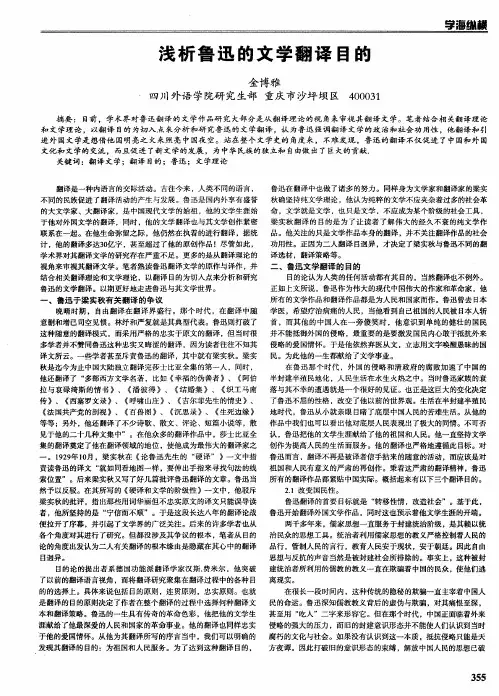
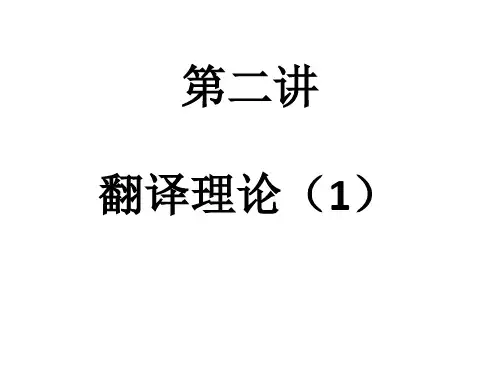
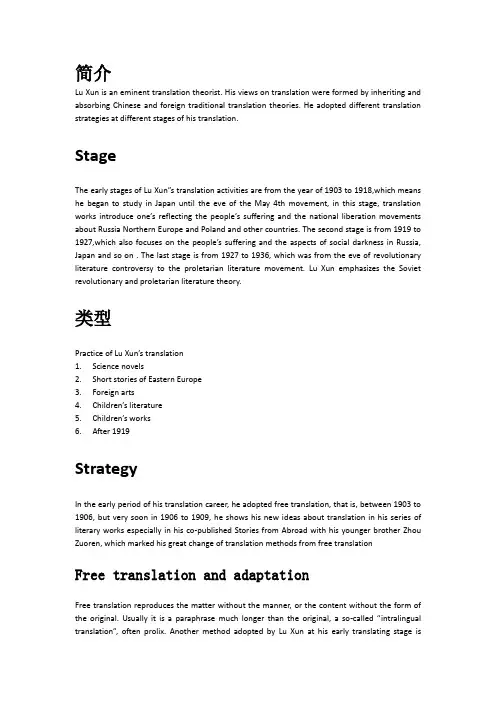
简介Lu Xun is an eminent translation theorist. His views on translation were formed by inheriting and absorbing Chinese and foreign traditional translation theories. He adopted different translation strategies at different stages of his translation.StageThe early stages of Lu Xun”s translation activities are from the year of 1903 to 1918,which means he began to study in Japan until the eve of the May 4th movement, in this stage, translation works introduce one’s reflecting the people’s suffering and the n ational liberation movements about Russia Northern Europe and Poland and other countries. The second stage is from 1919 to 1927,which also focuses on the people’s suffering and the aspects of social darkness in Russia, Japan and so on . The last stage is from 1927 to 1936, which was from the eve of revolutionary literature controversy to the proletarian literature movement. Lu Xun emphasizes the Soviet revolutionary and proletarian literature theory.类型Practice of Lu Xun’s translation1.Science novels2.Short stories of Eastern Europe3.Foreign arts4.Children’s literature5.Children’s works6.After 1919StrategyIn the early period of his translation career, he adopted free translation, that is, between 1903 to 1906, but very soon in 1906 to 1909, he shows his new ideas about translation in his series of literary works especially in his co-published Stories from Abroad with his younger brother Zhou Zuoren, which marked his great change of translation methods from free translationFree translation and adaptationFree translation reproduces the matter without the manner, or the content without the form of the original. Usually it is a paraphrase much longer than the original, a so-called “intralingual translation”, often prolix. Another method adopted by Lu Xun at his early translating stage isadaptation, the “freest” form of translation, the source culture converted to target language and the text rewritten.Stiff or literal translation(直译与硬译)The literal translation here doesn’t mean the literal translation we usually refer to, but Lu Xun’s translation strategy of adhering to the source language text or foreignization or “rigid translation”. For the literal translation generally means that the source language grammatical constructions are converted to their nearest target language equivalent, but the lexical words are again translated single, out of context. While Lu Xun’s literal translation is far beyond this. He laid much emphasis on the faithfulness to original forms, and the uniqueness in his literal translation is that he emphasizes the faithfulness at the level of grammatical structures of source language in his Chinese version. For Lu Xun, this is one of the feasible ways to preserve the original mood and flavor in Chinese version or “preserve the exoticism”.Faithfulness and smoothness(宁信而不顺)Lu Xun advocated “faithfulness and smoothness”, he protested “smoothness but unfaithfulness”. In Letters of Translation(《关于翻译的通信》), he says: "I still prefer "faithfulness" than "smoothness". Naturally, the "non-smoothness" does not mean"kneel" is translated into“跪在膝之”,"the Milky Way" into“牛奶路”.I mean the translations need to be chewed with great effort, not to be swallowed down in several mouthfuls just like drinking teas and eating. Here comes the question: Why not be completely sanitized to save labors of the readers? ...My answer is, this is also translation. Such translation introduces not only new subject matter, but also new ways of expression. The mind of Chinese language is not clear. To remedy that, we will have to undergo a little ordeal, that is, to bring in bizarre ways of constructing sentences---ancient, outlandish, foreign ways, incorporating them into our language. This is not imaginative.“non-smoothness” Lu Xun advocated in translation means introducing new subject matter as well as new ways of expression. And a part of the translation will became smooth from its non-smoothness and part of it will be cast away and kicked off because of its “non-smoothness”.主要翻译作品日本武者小路实笃著戏曲《一个青年的梦》日本厨川白村著论文《苦闷的象征》、《出了象牙之塔》俄国爱罗先珂著童话剧《桃色的云》后人评价Translating foreign literature is an important way for Lu Xun to put his literary values into practice.Lu Xun’s talks about translation purpose, source text selecting, translation strategies and methods, classification of target readers, and translation evaluation give an expression to his value orientation towards serving the readers by “stealing foreign fire”(“窃得洋火照人间”) His views on the value of translation, the value of “other” cultures and the translator’s responsibility imply his profound thoughts on translation ethics, from which some inspiration can be drawn.名人评价鲁迅先生不仅是我国伟大的文学家·思想家,也是一位伟大的翻译家。
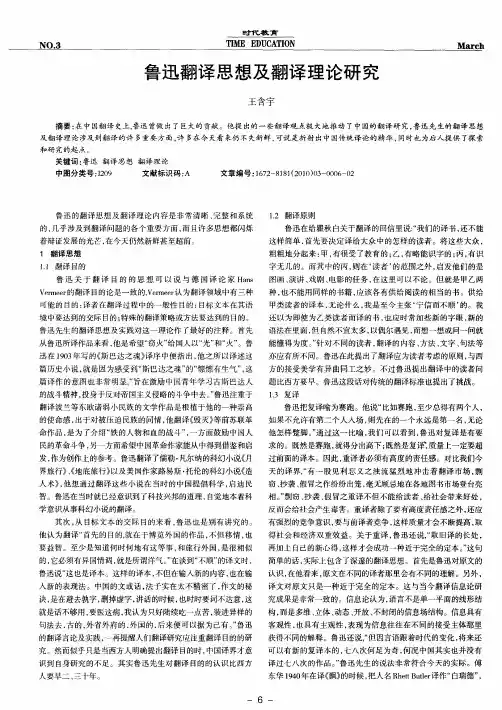
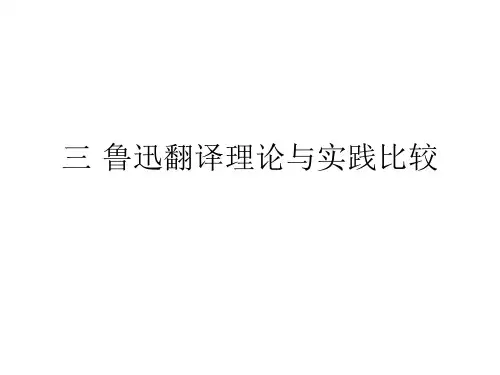
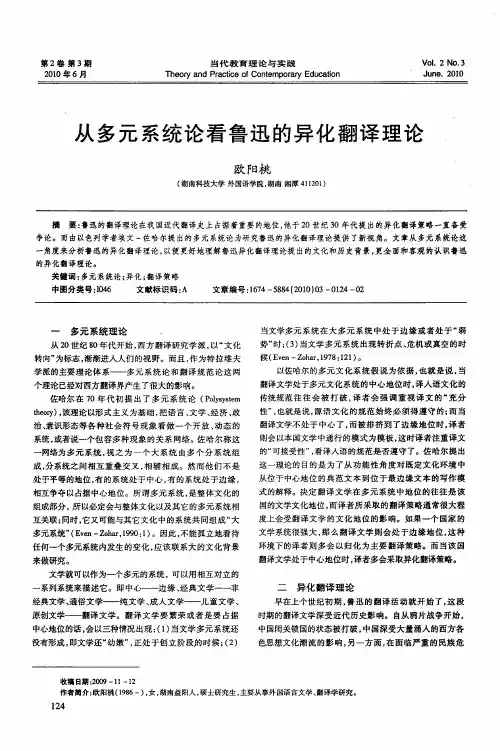

从中国历史上四次翻译高潮谈翻译理论的发展——张景丰翻译是不同民族进行交流的重要媒体之一。
在中国历史上,周朝已开始设译官,此后出现过多次翻译高潮,每次高潮都涌现出许多优秀的翻译理论家,经百家争鸣,翻译理论不断发展、进步、趋于完善。
因此要了解翻译理论的发展,须了解翻译的历史,总结经验。
下面仅从中国历史上出现的四次翻译高潮对翻译理论的发展予以探讨。
第一次翻译高潮:东汉至唐宋时期在三国时期,支谦的《法句经序》中提出了“因循本旨,不加文饰”的译经原则。
有人认为,支谦此序“可以算是最初的直译说了”(罗根泽语)。
晋、前秦时道安继而在《革卑婆沙序》中提出了比支谦更为明确的主张,即“案本而传,不令有损言游字;时改倒句,余尽实录。
”道安涉及译论的佛经序文较多,最有名的是提出“五失本”、“三不易”之说。
其意思是,翻译佛经在五种情况下会失去本来面目,有三件事决定了译事是很不容易的,因此必须慎之又慎。
北朝末年及隋初,彦琮著《辨证论》,它可以看作是我国第一篇翻译专论,他主张译经“宁贵朴而近理,不用巧而背源”。
可见他也是坚持忠实第一并倾向于直译的。
以上三家的论点颇为近似,他们的原则可以概括为“重质朴,轻文采”。
唐代僧人玄奘,其真本领在于翻译佛经,是中国佛经翻译史上集大成并后来居上的翻译家,他不仅译出了七十五部佛经,而且还把老子的部分著作译成梵文,成了第一个向国外介绍汉语著作的中国人。
他的指导原则就是:“既须求真,又须喻俗”。
“求真”即追求准确,要力求“忠实原作”,这是一切认真负责的翻译工作者的共同理想。
同时必须“喻俗”,亦即使群众理解,这就是说要“通顺”。
道宣在《续高僧传》中对玄奘及其前辈的佛经翻译作了比较,他说:“自前代以来,所译经教,初从梵语,倒写本文;次乃回之,顺同此俗。
然后笔人观理文句,中间增损,多坠全言。
今所翻传,都由奘旨,意思独断,出语成章。
词人随写,即可披玩”。
不难看出,玄奘在翻译上已达到炉火纯青、得心应手的熟练程度。
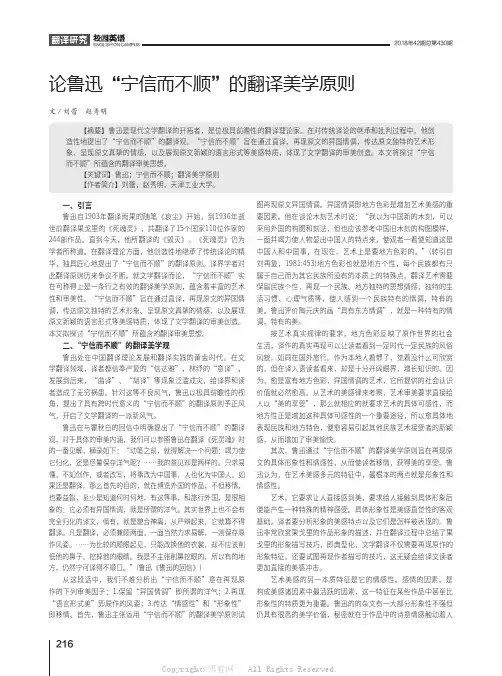
2162018年42期总第430期ENGLISH ON CAMPUS论鲁迅“宁信而不顺”的翻译美学原则文/刘蕾 赵秀明一、引言鲁迅自1903年翻译雨果的随笔《哀尘》开始,到1936年逝世前翻译果戈里的《死魂灵》,共翻译了15个国家110位作家的244部作品。
直到今天,他所翻译的《毁灭》、《死魂灵》仍为学者所称道。
在翻译理论方面,他创造性地继承了传统译论的精华,独具匠心地提出了“宁信而不顺”的翻译原则。
译界学者对此翻译原则历来争议不断。
就文学翻译而论,“宁信而不顺”实在可称得上是一条行之有效的翻译美学原则,蕴含着丰富的艺术性和审美性。
“宁信而不顺”旨在通过直译,再现原文的异国情调,传达原文独特的艺术形象、呈现原文真挚的情感,以及展现原文新颖的语言形式等美感特质,体现了文学翻译的审美创造。
本文拟探讨“宁信而不顺”所蕴含的翻译审美思想。
二、“宁信而不顺”的翻译美学观鲁迅处在中国翻译理论发展和翻译实践的黄金时代。
在文学翻译领域,译者都信奉严复的“信达雅”,林纾的“意译”,发展到后来,“曲译”、“胡译”等现象泛滥成灾,给译界和读者造成了无穷祸患。
针对这等不良风气,鲁迅以极具前瞻性的视角,提出了具有跨时代意义的“宁信而不顺”的翻译原则予正风气,开启了文学翻译的一派新风气。
鲁迅在与瞿秋白的回信中明确提出了“宁信而不顺”的翻译观,对于具体的审美内涵,我们可以参照鲁迅在翻译《死灵魂》时的一番见解,摘录如下:“动笔之前,就得解决一个问题:竭力使它归化,还是尽量保存洋气呢?……我的意见却是两样的。
只求易懂,不如创作,或者改写,将事改为中国事,人也化为中国人。
如果还是翻译,那么首先的目的,就在博览外国的作品,不但移情,也要益智,至少是知道何时何地,有这等事,和旅行外国,是很相象的:它必须有异国情调,就是所谓的洋气。
其实世界上也不会有完全归化的译文,倘有,就是貌合神离,从严辩起来,它就算不得翻译。
凡是翻译,必须兼顾两面,一面当然力求易解,一则保存原作风姿。

鲁迅的语言翻译观研究作者:罗星来源:《北方文学》2018年第33期摘要:本文分析研究了鲁迅硬译翻译观形成的原因和影响,并力图从更客观公正角度对其进行评价,希望能对鲁迅翻译研究提供一些有用的建议。
关键词:鲁迅语言翻译观;硬译一、鲁迅的硬译最能体现鲁迅翻译思想观的就是他所提倡的“硬译”思想。
所谓硬译即在翻译过程中极大地忠实于原著的语言风格,尽量保留其词法和句法,高度还原原文的一种直译。
鲁迅在《托尔斯泰之死与少年欧罗巴》的译者跋语中写道:“……在我,是除了还是这样的硬译之外,只有“束手”这一条路——就是所谓没有出路——了。
”这应该是硬译的最早出处,后来鲁迅硬译的说法就此流传开来。
鲁迅早期的翻译明显受到林纾和严复二人的影响,倾向于意译,在翻译凡尔纳的科学小说《月界旅行》时不仅用的是章回体的文言,对原作也有不少改动和删减。
其目标也和林严二人相似,希望借助外来科学思想的传播实现自己改造中国国民性,救助中国的理想。
后来鲁迅发现流行的林氏译法误译太多,不满于意译中原文的失真,开始慢慢转向直译,《域外小说集》就是他的尝试之一,尽管使用的还是文言形式,但在词语和语句上都采用直译,尽可能保留原文的句式结构,对原文的人名地名的翻译都做了保留,这与当时的译文中凡人名地名都要改成国人熟悉的中文名称是大相径庭的。
“译亦期弗失文情”的硬译,对当时意译一统天下的翻译界来说是具有开拓创新意义的,尽管当时并没有引起太大的反響,但仍然可以说它是后世直译的一个开端。
鲁迅希望通过翻译引入西方文明的异质文化来改造和促进中国文化的发展,他认为翻译信而不顺至多不过看不懂,想一想也许能懂。
而曲译译得顺而不信,令人迷误,反倒有害。
而硬译能最大程度的保留原文的洋气,能更好的让读者去领会作者的思想,这才是翻译的真正用途。
他希望硬译能作为通向未来正确翻译发展方向的一个桥梁,为后世的译文提供一点经验和借鉴。
从这个角度来说,鲁迅是极具有未来发展眼光和前瞻性的。
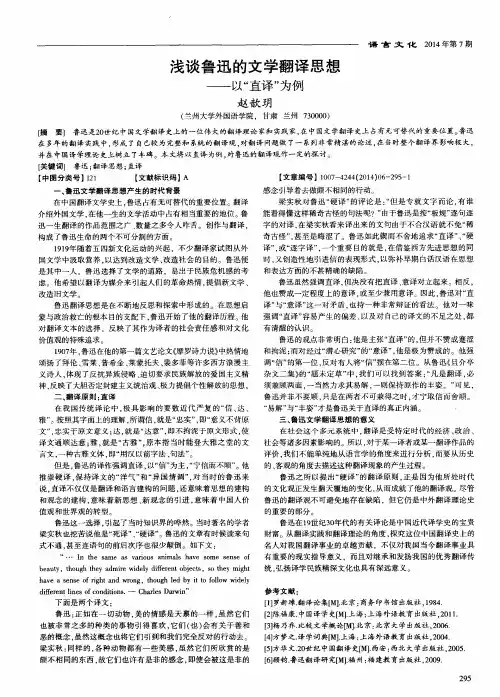
论翻译的语言学问题翻译主体的身份和语言问题——以鲁迅与梁实秋的翻译论争为中心1929 年9 月10 日,梁实秋( 1903 -1987)的批评文章《论鲁迅先生的“硬译”》在《新月》杂志上刊出。
此文引发了1930年代前期有关翻译问题的论争,在中国现代翻译史上具有标志性意义。
梁文发表半年之后的1930年年3月,鲁迅(1881 - 1936)发表回应文章《“硬译”与“文学的阶级性”》,论争局面初步形成。
1931 年12 月,鲁迅在《几条“顺”的翻译》一文中指出∶“在这一个多年之中,拚死命攻击‘硬译’的名人,已经有了三代:首先是祖师梁实秋教授,其次是徒弟赵景深教授,最近就来了徒孙杨晋豪大学生。
”由此可见论争之延续性。
同样是在1931年12月,鲁迅与瞿秋白用通信的方式讨论翻译问题,并先后将通信发表在《十字街头》和《文学月报》,有关翻译的讨论高潮再起。
鲁迅对翻译论争的参与,至少持续到1935年4月《非有复译不可》一文在上海《文学》月刊上发表。
这场翻译论争①发生在无产阶级文学兴起和“翻译洪水泛滥”②的特殊时期,由于众多翻译家的参与,涉及翻译的政治性、译者的身份以及翻译美学等中国现代翻译学发展过程中的基本问题,并与清末至1920年代中国固有的翻译观念构成关联。
本文试图以鲁迅与梁实秋的相关文章为中心,对此进行考察。
一翻译理论与政治性梁实秋《论鲁迅先生的“硬译”》的立论是从讨论“死译”和“曲译”的优劣开始的。
文章开头引用陈西滢的观点——所谓“死译的病虽然不亚于曲译,可是流弊比较的少,因为死译最多不过令人看不懂,曲译却愈看得懂愈糟”,在此基础上反陈西滢之道而行之,认为“曲译”与“死译”相比尚有可取之处,理由是“曲译”不会通篇皆“曲”,“读的时候究竟还落个爽快”,而“死译一定是从头至尾的死译,读了等于不读,枉费时间精力。
况且犯曲译的毛病的同时绝不会犯死译的毛病,而死译者却不妨同时是曲译。
”那么何谓“死译”? 梁实秋依然是引用陈西滢的话——“他们非但字比句次,而且一字不可增,一字不可先,一字不可后,名曰翻译:而‘译犹不译’,这种方法,即提倡直译的周作人先生都谥之为‘死译’。
主张直译的鲁迅,矛盾,释道安:东晋前秦时高僧,主张直译,译文不增不减只在词序上作些调整;玄zhuang: 唐高僧,倾向于直译,“既须求真,又须喻俗”。
矛盾:主张直译,同时又提倡保留“神韵”。
关于直译直译就浅处说,是“不妄改原文的字句”,就深处说,还求“能保留原文的情调与风格”。
赵景深“宁顺而不信”鲁迅“宁信而不顺”,强调要输入新的表现法所以现在要容ren“多少的不顺”。
主张直译瞿秋白:信和顺不应当对立起来。
鲁迅:“凡是翻译,必须兼顾着两面,一当然要力求其易解,一则保存着原作的丰姿”,也就是说,翻译既要通顺,又要忠实。
主张意译的:鸠摩罗什:后秦高僧。
倾向于意译,常对原文加以改动,以适应中国的文体。
严复;信(忠实)达(流畅)雅(尔雅)周煦良:“信达雅哪个最重要?要看内容而定。
一篇译文如果在内容上是忠实的,在语言上是通顺的,在风格上是得体的,那的确就是一篇好译文了。
林纾:以文言文翻译欧美小说184种。
G ulliver’s Travels, 海外轩渠录David Copperfield块肉余生述Oliver Twist贼史钱钟书:在“林杼的翻译”一文中,提出“文学翻译的最高标准是化,把一国的文学作品译成另一国文字,既能不因语言习惯的差异而露出生硬牵强的痕迹,又能完全保存原有的风味,那就算“入得化境”。
(仅限于文学作品)郭沫若“好的翻译等于创作,甚至可能超过创作““信达雅确实是必要条件,……尤其是文学作品,信达之外,愈雅愈好”认为直译和意译是一回事的四五十年代:朱光潜:“直译不能不是意译,而意译也不能不是直译”林汉达:“正确的翻译分不出直译或者意译”周建人:直译不是“字典译法,也不是……它是要求真正的意译七八十年代:周煦良:直译的毕竟是少数许渊冲:哪种方式有力有哪种王佐良:“凡能直译处坚持直译,必须意译处则放手意译“适合就是一切“傅雷:“重神似不重形似“翻译重在实践”“得其精而忘其粗,在其内而忘其外”“关于风格:支持能译的:矛盾、是“不妄改原文的字句”,就深处说,还求“能保留原文的情调与风格”。
论鲁迅的翻译策略摘要:鲁迅是中国伟大的文学家、翻译家和新文学运动的奠基人。
他致力于翻译,出于实现“醒世、觉世”的政治抱负。
他针对不同的作品,运用多维度、独异性的翻译策略,不仅达到了其政治目的,还开拓了中国翻译文学的新路,创一代翻译之新风。
鲁迅的翻译策略不仅体现了其政治取向,还体现了翻译与政治、翻译与文化的密切联系——即翻译不是远离政治、意识形态和利益冲突的行为,翻译与政治、意识形态、社会、文化环境等因素联系密切,译者深受这些因素的影响。
关键词:鲁迅;翻译策略;政治;多维;独异一、引言翻译外国文学作品,在鲁迅的文学生涯中占有极其重要的位置。
他本人对翻译工作异乎寻常地重视,曾把翻译工作提高到“正业”的高度,一度“想以此作谋生”①。
他坦言自己从翻译外国文学作品中受益匪浅。
鲁迅从事翻译的时间前后达33年(1903—1936)之久,译介了大量的外国作品。
据不完全统计,有来自俄国、英国、波兰、捷克、日本等14个国家的近100位作家的200多种作品,翻译字数达500多万,占其作品的半壁江山。
他翻译的文学作品种类繁多,涉及小说、戏剧、童话、杂文、诗歌、文艺理论等。
最为引人瞩目的是,鲁迅有关翻译的理论几乎涵盖了翻译的各个重要方面。
他为中国现代文学提出了不落俗套的、标新立异的、意义深远的翻译理论。
尤其是他所倡导和运用的多维度、独异性的翻译策略,是我国现代翻译史上的一笔宝贵财富,至今对我国的文学翻译具有积极的意义。
二、鲁迅翻译的策略——多维度、独异性德国功能翻译学派代表人物之一汉斯·弗米尔(Hans J.Vermeer)在其目的论(Skopostheory)中认为,翻译是基于源语文本的一种转换行为,任何行为都有一定的目标或目的,而且一种行为会导致一种结果、一种新的语境或事件。
在目的论框架中,决定翻译目的的最重要因素是译文预期的接受者或受众者,他们有自己独特的文化知识、有自己对译文的期待和交际需要。
②根据这一理论,翻译是有一定目的的,译者在翻译某一作品时所持有的目的和意图是翻译批评者所考虑的一个重要因素;而译者可依据自己的翻译目的来决定采取哪种翻译行动。